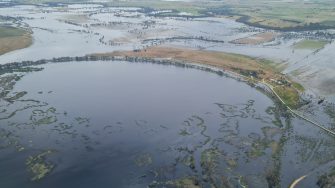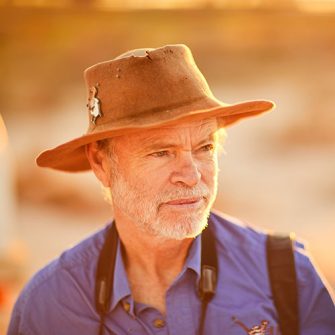
Date: Monday October 31st 2022
Project: Eastern Australian Waterbird Survey
Observers: Richard Kingsford & John Porter
Pilot: Tim Dugan
We headed for Albury under oppressive skies. It looked like it was going to be a miserable day of survey. We were a bit worried that we weren't going to be able to do any down the River Murray to Mildura. Thankfully the skies cleared when we arrived in Albury. From here we headed west down the River Murray. There was water flooding out across the floodplains and billabongs all the way along the river.
River Murray flooding just west of Albury.
We got to Lake Mulwala, the weir pool on this part of the Murray and it was full to the brim. Few waterbirds but as usual there was a small pelican colony on an island. Yarrawonga Weir which stores the water was letting water pour down the main river channel.
Surveying Lake Mulwala, the weir pool created by Yarrawonga Weir on the River Murray.
Surveying Middle Lake.
When we reached the extensive Barmah-Millewa forest, the largest river red gum forest in the Murray-Darling Basin, the flood was right across the wetland, which is a pretty rare event. When this happens, we have to resort to using transects to survey.
A fully flooded Barmah-Millewa Forest, right across the wetland.
These define a 200 metre swathe, moving from north to south across the wetland. We two counters estimate the number of waterbirds underneath a 100 metre transect on each of our sides of the plane, demarcated by a black marker on the wing strut.
Surveying a reedbed swamp in the Barmah-Millewa Forest.
There were relatively few waterbirds across the river red gum forest. But a few pairs of ducks probably indicated breeding, another common observation during this survey. After we had done all five transects, we surveyed the main reedbed swamps, Moira Lake and Barmah Lake.
Surveying Moira Lake, part of the Barmah-Millewa Forest.
This flood was so big that you could see the ‘sharp’ boundaries of the forest. In fact, the water was ‘butting’ up to the agricultural areas which were protected from flooding by small levee banks, constraining the flooding to the forest. In the past, flooding would have been even more extensive, across a much bigger floodplain.
Surveying Barmah Lake, part of the Barmah-Millewa Forest.
Then it was on to the Koondrook-Perricoota Forest, another extensive river red gum forest. There were few waterbirds in the forest with water everywhere as far as the forest extended.
Everywhere along the floodplain of the River Murray, there was evidence of the impacts of flooding on people. Crops were inundated; some houses flooded and lots of infrastructure such as yards under water. As we flew west, the storms were starting to sweep across.
Storms coming across from the west.
It was then on to survey a standard few kilometre stretch of the river which we survey each year, west of the forests. Once again, flooding was extensive. Even though it wasn’t that windy, it was still really bumpy, probably from the air turbulence with the coming weather.
We decided we needed a break in Kerang in Victoria, near the Kerang Lakes. This area is an important part of the River Murray’s floodplain and all its many lakes and swamps were full (we had surveyed them in the weeks before) with water blowing out across the floodplain, now cropped areas. Lots of houses and infrastructure were under water.
Widespread flooding around Kerang.
From here, it was on to the Hattah-Kulkyne Lakes. This group of lakes in Victoria is part of a National Park and a wetland of international significance, under the Ramsar Convention.
Hattah Lakes.
All the major lakes had water but surprisingly not all of the channels and floodplains were full. Given how much water there was in the main river, we had expected that the adjoining floodplains to be fully flooded.
Surveying Hattah Lakes.
Again there were relatively few waterbirds but, there were a few colonies of great cormorants breeding, indicative of the productivity of the system.
Few waterbirds on Hattah Lakes, apart from a few breeding cormorants.
We finished off by surveying a short area along the river south of Mildura.
River Murray and its extensively inundated floodplains, just south of Mildura.
Late in the afternoon, we arrived in Mildura.

